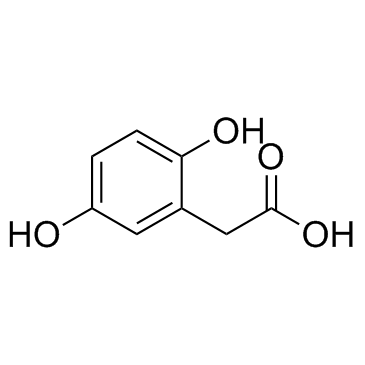HOMOGENTISIC ACID

HOMOGENTISIC ACID structure
|
Common Name | HOMOGENTISIC ACID | ||
|---|---|---|---|---|
| CAS Number | 451-13-8 | Molecular Weight | 168.147 | |
| Density | 1.5±0.1 g/cm3 | Boiling Point | 439.3±30.0 °C at 760 mmHg | |
| Molecular Formula | C8H8O4 | Melting Point | 150-152 °C(lit.) | |
| MSDS | USA | Flash Point | 233.6±21.1 °C | |
| Symbol |

GHS07 |
Signal Word | Warning | |
|
Automated screening of urine samples for carbohydrates, organic and amino acids after treatment with urease.
J. Chromatogr. A. 562(1-2) , 125-38, (1991) Eighty-five clinical urine samples and nineteen urine samples previously found by other laboratories to suggest genetic metabolic defects were prepared for trimethylsilylation by treatment with urease, followed by azeotropic dehydration. The "Target Analyte S... |
|
|
Mass spectrometric behavior of phenolic acids standards and their analysis in the plant samples with LC/ESI/MS system.
J. Chromatogr. B. Analyt. Technol. Biomed. Life Sci. 967 , 21-7, (2014) Liquid chromatography coupled to mass spectrometry (MS) with electrospray ionization (ESI) is one of analytical techniques to obtain accurate results of low molecular weight aromatic compounds in biological samples of different origin. The interpretations of ... |
|
|
The homogentisate and homoprotocatechuate central pathways are involved in 3- and 4-hydroxyphenylacetate degradation by Burkholderia xenovorans LB400.
PLoS ONE 6 , e17583, (2011) Genome characterization of the model PCB-degrading bacterium Burkholderia xenovorans LB400 revealed the presence of eleven central pathways for aromatic compounds degradation, among them, the homogentisate and the homoprotocatechuate pathways. However, the fu... |
|
|
Antioxidant capacities, phenolic compounds and polysaccharide contents of 49 edible macro-fungi.
Food Funct. 3(11) , 1195-205, (2012) Edible macro-fungi are widely consumed as food sources for their flavors and culinary features. In order to explore the potential of macro-fungi as a natural resource of bioactive compounds, the antioxidant properties and polysaccharide contents of 49 edible ... |
|
|
Natural history of alkaptonuria revisited: analyses based on scoring systems.
J. Inherit. Metab. Dis. 34(6) , 1141-51, (2011) Increased circulating homogentisic acid in body fluids occurs in alkaptonuria (AKU) due to lack of enzyme homogentisate dioxygenase leading in turn to conversion of HGA to a pigmented melanin-like polymer, known as ochronosis. The tissue damage in AKU is due ... |
|
|
A quantitative assessment of alkaptonuria: testing the reliability of two disease severity scoring systems.
J. Inherit. Metab. Dis. 34(6) , 1153-62, (2011) Alkaptonuria (AKU) is due to excessive homogentisic acid accumulation in body fluids due to lack of enzyme homogentisate dioxygenase leading in turn to varied clinical manifestations mainly by a process of conversion of HGA to a polymeric melanin-like pigment... |
|
|
Alkaptonuria.
Dermatol. Online J. 16(11) , 6, (2010) A 69-year-old woman presented with a 30-year history of lower back and large joint pain of the hips and shoulders. On examination blue-grey, pigmented macules were present over the cartilaginous portions of the ears and on the sclera. Past medical history inc... |
|
|
A 3-year randomized therapeutic trial of nitisinone in alkaptonuria.
Mol. Genet. Metab. 103(4) , 307-14, (2011) Alkaptonuria is a rare, autosomal recessive disorder of tyrosine degradation due to deficiency of the third enzyme in the catabolic pathway. As a result, homogentisic acid (HGA) accumulates and is excreted in gram quantities in the urine, which turns dark upo... |
|
|
Anticholinesterase activity of selected phenolic acids and flavonoids - interaction testing in model solutions.
Ann. Agric. Environ. Med. 22 , 690-4, (2015) Alzheimer's disease is a progressively developing neurodegenerative disorder of the central nervous system. The only present treatment of this disease is the use of acetyl- and butyrylcholinesterase inhibitors. Previously, the neuroprotection of phenolic acid... |
|
|
DFT for exploring the antioxidant potential of homogentisic and orsellinic acids.
Pak. J. Pharm. Sci. 26(6) , 1209-14, (2013) In recent years, much attention has been focused on the antioxidant potential of different phenolic acids. But still no theoretical investigation is reported on the antioxidant potential of Homogentisic and Orsellinic acids. In this study, computational inves... |